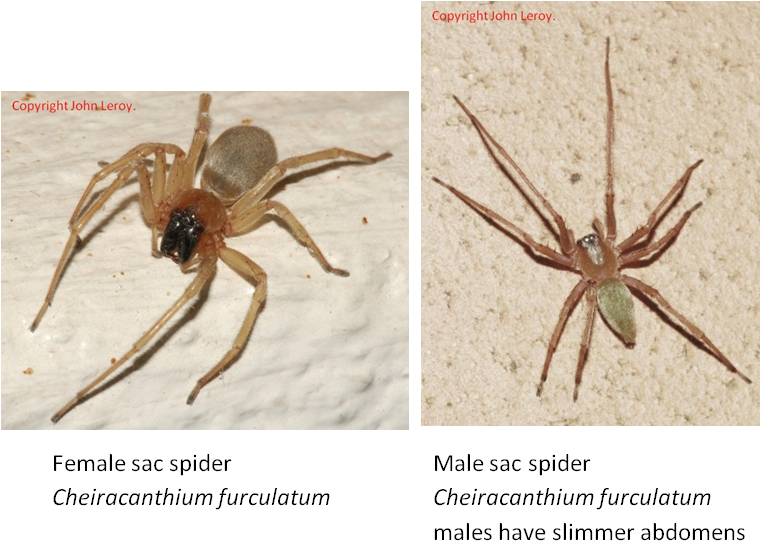And so to the last in our series.
SAC SPIDERS, YELLOW SAC SPIDERS, HOUSE SAC SPIDERS, LONG-LEGGED SAC SPIDERS – these are various common names given to the very common spider Cheiracanthium furculatum in the family Eutichuridae
Since the early 1980’s bites from the common House Sac spider Cheiracanthium furculatum have been believed to be medically important and to cause slow-healing (necrotic) sores. This reputation came about from a study conducted several decades ago using circumstantial evidence. We are not sure how the researchers proved that the sores were caused by a spider bite.
The media got hold of this research, it was repeated many times in both scientific and popular literature and a legend was born. Recent research suggests that their venom does not contain the compound that causes necrosis and that this reputation could be undeserved. (See reference section Vetter,R.S., Isbister, G.K., Bush, S.P., Boutin, L.J. Verified bites by yellow sac spider, etc.). House sac spiders are probably no more or less dangerous to humans than any other spider and like all spiders they try their best to avoid contact with us.

NOTES FOR MEDICAL PRACTITIONERS
Rick Vetter (2006) a medical entomologist from the USA says: “One of the very real problems with arthropod bites is that the bite causes itching, the victim scratches, introduces a secondary bacterial infection from grungy fingernails and such, a horrific wound shows up and then the wound is solely blamed on the arthropod when the real culprit is the bite victim him/herself.”
So when presented with a necrotic lesion think bacterial infection or one of the following possible diagnoses to be investigated before blaming a spider:
ALTERNATIVE DIAGNOSES
Table 1.—A list of medical conditions that have been or could be misdiagnosed as cutaneous loxoscelism. Modified from Swanson & Vetter (2005)
Infections
Atypical mycobacteria
Bacterial Streptococcus – Staphylococcus (especially MRSA) – Lyme borreliosis – Cutaneous anthrax – Syphilis – Gonococcemia Ricketsial disease – Tularemia
Deep Fungal Sporotrichosis – Aspergillosis – Cryptococcosis
Ecthyma gangrenosum (Pseudomonas aeruginosa), Parasitic (Leishmaniasis), Viral (herpes simplex, herpes zoster (shingles)), Vascular occlusive or venous disease, Antiphospholipid-antibody syndrome, Livedoid vasculopathy,
Small-vessel occlusive arterial disease, Venous statis ulcer, Necrotising vasculitis, Leukocytoclastic vaculitis, Polyarteritis nodosa, Takayasu’s arteritis, Wegeners granulomatosis, Neoplastic disease, Leukemia cutis, Lymphoma (e.g., mycosis fungoides), Primary skin neoplasms (basal cell carcinoma, malignant melanoma), squamous cell carcinoma),
Lymphomatoid papulosis, Topical and Exogenous Causes, Burns (chemical, thermal), Toxic plant dermatitis, Factitious injury (i.e., self-induced), Pressure ulcers (i.e., bed sores), Other arthropod bites, Radiotherapy, Calcific uremic arteriolopathy, Cryoglobulinemia, Diabetic ulcer, Langerhans’-cell histiocytosis, Pemphigus vegetans, Pyoderma gangrenosum, Septic embolism
EDs Note:
Once again many thanks to Astri for allowing us to post her booklet, and if you are interested in a .pdf copy of it, then drop Peter Gordon-Cumming (VM82) an email and I will provide the Dropbox link.
And if you are not already on the Spider club mailing list you can find all the necessary details on their website – www.spiderclub.co.za








